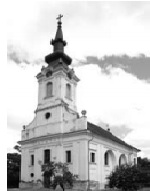The village of Bajša, a few kilometers away from Backa Topola, was in the possession of noble families Zako and Vojnic in the 18th century. When noblemen from the Zako family built a castle in their possession, they connected it through a courtyard garden with the newly built Orthodox Church of Sts. Dimitrija. The church was erected by the protector of Dimitri Zack, and its construction was completed in 1818, as it stands over the main entrance. The style of this building, in its external and internal forms and decorative details, maintains the architectural conceptions of the era in which it was created. The church is basically single-breed, east with rectangular singers, which come out of the base of the nausea with a slightly pointed arc, and with a semicircular apse in the interior, and three-sidedly finished from the outside.
On the western façade, shallow rhizalite flanked pilasters with semicolons of Ionian entrances. Above the profiled architrave is a frieze with a relief ornament, which consists of unchanged upright palm pavements and quadruple rosette. A classicist double-sided bell tower embroidered in the gates on the facade, at the ends of the acrobatics in the form of a vase with garlands, rises from the facade, and the gable wall ends with a baroque line.
The side facades are with two niches that mark the beds and are overlapped with semicircular arches, and they are highly segmented windows. In the attic there is a straight-drawn wreath.
The simple, elongated inner space of the temple is divided into semicircular arches and spherical vaults. The sides on the sides are relying on doubled classicist consoles, which are subjugated to short architrave cities. In the western part of the nave, the choir, on the ground floor, is surrounded by spherical vaults and ports, and on the first floor there is a full-walled fence of an irregularly shaped line shape. Above the hole in the choir were recorded in 1854 and MA 1893, possibly the dates of the restoration of the temple.
Iconostasis is the work of John Klajić from 1854, a pupil of the Vienna Academy of Arts. Although he belonged to the circle of Serbian romantics, he showed his tendency toward Nazarene and Classicism in his works. The signing of the painter is on the icon of the Virgin with Christ standing in the place of the Virgin Throne.
There is no icon in the socket, only there are frames in the form of a regular oval wreath interwoven with oak leaves.
The church preserves the icon of the Virgin with Christ – the work of an unknown author, oil, silver-coated wood, dim. 14 x 19 cm. Although it is a technique for tinning silver plates, the motifs are very precisely derived and properly shaped. The work was created no later than the first half of the 18th century and maybe it was Russian provenance.
Several icons on the glass by composition, figure formation and dark incarnation point to the work of the 18th century.
In the church, several objects of applied art were preserved and protected: petihlebnica, kadenica and silver bowl for the money donated by the founders of Dimitrije and Ekaterina Zako at the end of the construction of the church in 1818, as well as two tombstones of the Zako family.
SERBIAN ORTHODOX CHURCH OF ST. DIMITRIJA


0 comments on “SERBIAN ORTHODOX CHURCH OF ST. DIMITRIJA”